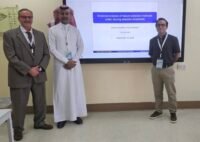Education Middle East speaks to well-being and mental health experts to find out
Dubai, Feb 17, 2022: Are our teachers struggling? The answer to this question lies in another question: How much are our teachers struggling? The well-being of teachers has emerged as a serious concern globally, and the UAE is no exception. The fault lines were first exposed in the aftermath of the COVID-19 lockdown.

Sven Maikranz, CEO of Upstrive, a tool that measures student and staff wellbeing and engagement, points out that though most professionals around the world had to deal with changes throughout the pandemic, teachers had to deal with some extraordinary situations due to the added human connection with children – one of the most vulnerable groups in our society.
The pandemic has caused lasting impact on teachers’ wellbeing around the world. According to the United Nations Educational, Scientific and Cultural Organization (UNESCO) (2020a), school closures, unpredictability about the duration of the pandemic and lack of experience with distance education has caused confusion and stress among teachers.
Teacher wellbeing has been found to be a critical concern in the UAE as well. Teacher shortage in schools across the UAE and changes in learning and teaching practices owing to the pandemic have added up to the stress level among teachers. Furthermore, requirements to transform to home-schooling almost overnight including the hybrid teaching system requiring more time to prepare for the classes, getting familiar with the various technologies in a short period and fear of potential staff and salary reductions, have been some of the contributing factors to additional stress among teachers.

“Yes definitely teachers have been stressed for the past two years. First it was the pressure of upskilling, understanding and adapting to the online / hybrid models. Now it is for being constantly vigilant for students’ physical distance, wearing of masks and other health and safety protocols. Every day the list changes, everyday students are going to quarantine. There are concerns at home too,” says Dr. Gilda Scarfe, CEO and Founder, Positive Ed Ltd – a global education consultancy.
A survey by the National Education Association (NEA), the US’ largest union that represents almost three million educators, says that due to large staff shortages in America’s public schools, educators are experiencing burn out.
UAE schools have also been facing staff shortages. (https://educationmiddleeast.com/features/uae-schools-face-teacher-shortage/) amidst increasing enrollments and reduction in international workforce.

As Mark Samways, Director of Wellbeing, The Free Spirit Collective – a mindfulness, acceptance and commitment training provider, says the additional stress on teachers during this pandemic has been enormous. “I’m sure if you asked any teacher, they would not like to hear the term ‘blended learning’ ever again. It’s been an incredibly challenging period of time and one that educators have done brilliantly in. It was a very quick adjustment in a short period of time,” he says.
“Some issues are out of our control but we really must adjust our expectations during these difficult times. We also must be careful with the language we use, calling it the ‘new normal’ is wrong and unhelpful. Nothing about this experience has been ‘normal’ and by calling it the ‘new normal’ it invalidates the experiences that we are each going through,” says Samways adding that the work conditions are so severe that half of all teachers leave the profession in the first five years and workload plays a huge role in this.
Some of the contributing factors causing additional stress among teachers have been identified as the requirements to “transform” to home-schooling almost overnight, introduction of the hybrid teaching system, adapting to new technologies within a short period, and most importantly fear of potential staff and salary reductions.
The NEA survey also shows that the burn out resulted in about 55% of educators planning to leave the profession earlier than what they had planned.
According to Samways, “Teacher burnout is a global concern. Our concern shouldn’t be ‘how can we avoid it’ because it’s here, it’s real. We need to firstly acknowledge the burnout culture in the profession and then question what changes we can make,” he says, adding that currently more and more expectation is being added with little being taken away.
“Schools can make small adjustments on expectations of teachers that will go a long way in supporting staff wellbeing. They will also need to communicate these temporary changes to parents, who I’m sure, will be understanding,” says Samways.

Teachers’ wellbeing goes beyond a coffee machine in the staff room or telling teachers to take up yoga, says Robert Welsh, Founder of Teachers Social, a teacher wellbeing organisation in the UAE. “The responsibility for teachers’ wellbeing also lies with the management and owners of the school,” says Welsh who also warned that unless the management learns to respect that teachers need to cut off, rest and recuperate after long hours burning both ends of the candle mentally and physically in the classroom, mentoring and acting as a parent to other people’s children, the sector might lose the majority of great and experienced talent, replaced by “New” teachers who lack experience or depth of knowledge.
To improve teacher wellbeing in the UAE, “Schools need to collaborate on best practices. If they don’t have someone in-house that has a significant understanding of the research and principles of wellbeing, then they need to reach out to organisations that can help. Ongoing partnerships and collaboration is the only way to make generational changes, which is what is required, says Samways.
Maikranz says that the key is to involve all stakeholders in the process so their experience and knowledge can be used. This does not only create an amazing brain pool, but it also creates the feeling of empowerment which in return increases engagement. And since wellbeing management is not a core competency of most teachers, they often feel overwhelmed with the responsibility. Bite-sized content and programmes that teachers can apply and use for students and themselves could be of help, he adds.
There are programmes and initiatives run by expert groups to promote wellbeing among teachers and schools in the UAE. “We encourage teacher social gatherings outside the classroom so teachers learn to disengage from work and work towards finding the right life-work balance,” says Welsh.
Meanwhile, Samways is of the opinion that it is crucial that teachers need an understanding of the science of wellbeing and hence should form part of teacher training.
However, Maikranz believes that wellbeing has become an important topic in recent times in the UAE. “Just the fact that wellbeing is on the agenda, part of surveys and audits is a remarkable difference to many countries in the world and shows how much the UAE values making wellbeing an integral part of the education system. The annual comprehensive wellbeing survey in schools is a big step forward,” says Maikranz.
Meanwhile, experts have welcomed the move by the government to implement a four-and-a-half-day working week in the UAE. “When it comes to wellbeing, it’s crucial to be guided by research and data. Some research within the literature does suggest that reducing the working week can help improve wellbeing without harming productivity, therefore UAE has taken the bold step to implement this strategy. It’s certainly forward thinking and in my view should be applauded,” says Samways while Scarfe says that UAE is working at enhancing wellbeing strategically, with 4.5 days of work definitely a step in the right direction.








